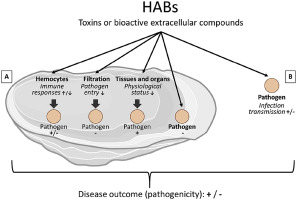Developmental & Comparative Immunology ( IF 2.7 ) Pub Date : 2020-03-05 , DOI: 10.1016/j.dci.2020.103660 Malwenn Lassudrie 1 , Hélène Hégaret 2 , Gary H Wikfors 3 , Patricia Mirella da Silva 4

|
Bivalves were long thought to be “symptomless carriers” of marine microalgal toxins to human seafood consumers. In the past three decades, science has come to recognize that harmful algae and their toxins can be harmful to grazers, including bivalves. Indeed, studies have shown conclusively that some microalgal toxins function as active grazing deterrents. When responding to marine Harmful Algal Bloom (HAB) events, bivalves can reject toxic cells to minimize toxin and bioactive extracellular compound (BEC) exposure, or ingest and digest cells, incorporating nutritional components and toxins.
Several studies have reported modulation of bivalve hemocyte variables in response to HAB exposure. Hemocytes are specialized cells involved in many functions in bivalves, particularly in immunological defense mechanisms. Hemocytes protect tissues by engulfing or encapsulating living pathogens and repair tissue damage caused by injury, poisoning, and infections through inflammatory processes. The effects of HAB exposure observed on bivalve cellular immune variables have raised the question of possible effects on susceptibility to infectious disease. As science has described a previously unrecognized diversity in microalgal bioactive substances, and also found a growing list of infectious diseases in bivalves, episodic reports of interactions between harmful algae and disease in bivalves have been published. Only recently, studies directed to understand the physiological and metabolic bases of these interactions have been undertaken. This review compiles evidence from studies of harmful algal effects upon bivalve shellfish that establishes a framework for recent efforts to understand how harmful algae can alter infectious disease, and particularly the fundamental role of cellular immunity, in modulating these interactions.
Experimental studies reviewed here indicate that HABs can modulate bivalve-pathogen interactions in various ways, either by increasing bivalve susceptibility to disease or conversely by lessening infection proliferation or transmission. Alteration of immune defense and global physiological distress caused by HAB exposure have been the most frequent reasons identified for these effects on disease. Only few studies, however, have addressed these effects so far and a general pattern cannot be established. Other mechanisms are likely involved but are under-studied thus far and will need more attention in the future. In particular, the inhibition of bivalve filtration by HABs and direct interaction between HABs and infectious agents in the seawater likely interfere with pathogen transmission. The study of these interactions in the field and at the population level also are needed to establish the ecological and economical significance of the effects of HABs upon bivalve diseases. A more thorough understanding of these interactions will assist in development of more effective management of bivalve shellfisheries and aquaculture in oceans subjected to increasing HAB and disease pressures.
中文翻译:

海洋有害藻华对双壳类细胞免疫和传染病的影响:综述
长期以来,双壳类动物被认为是人类海鲜消费者的海洋微藻毒素的“无症状携带者”。在过去的三年里,科学已经认识到有害的藻类及其毒素可能对食草动物有害,包括双壳类动物。事实上,研究最终表明,一些微藻毒素起到了积极的放牧威慑作用。在应对海洋有害藻华 (HAB) 事件时,双壳类动物可以排斥有毒细胞,以最大程度地减少毒素和生物活性细胞外化合物 (BEC) 的暴露,或摄取和消化细胞,并结合营养成分和毒素。
几项研究报告了响应 HAB 暴露对双壳类血细胞变量的调节。血细胞是参与双壳类动物许多功能的特化细胞,特别是在免疫防御机制中。血细胞通过吞噬或包裹活病原体来保护组织,并通过炎症过程修复由损伤、中毒和感染引起的组织损伤。观察到的 HAB 暴露对双壳类细胞免疫变量的影响提出了可能对传染病易感性产生影响的问题。由于科学已经描述了微藻生物活性物质的先前未被认识的多样性,并且还发现了越来越多的双壳类传染病,因此已经发表了关于有害藻类与双壳类疾病之间相互作用的偶发报告。只是最近,已经进行了旨在了解这些相互作用的生理和代谢基础的研究。本综述汇集了藻类对双壳贝类有害影响研究的证据,为近期了解有害藻类如何改变传染病,特别是细胞免疫在调节这些相互作用中的基本作用的努力建立了框架。
此处审查的实验研究表明,HAB 可以通过多种方式调节双壳类动物与病原体的相互作用,或者通过增加双壳类动物对疾病的易感性,或者相反地通过减少感染增殖或传播。暴露于 HAB 引起的免疫防御改变和整体生理不适是这些对疾病影响的最常见原因。然而,到目前为止,只有少数研究解决了这些影响,无法建立一般模式。其他机制可能涉及但迄今为止研究不足,未来需要更多关注。特别是,HAB 对双壳贝类过滤的抑制以及 HAB 与海水中传染原之间的直接相互作用可能会干扰病原体的传播。还需要在田间和种群水平上研究这些相互作用,以确定 HAB 对双壳类疾病影响的生态和经济意义。更透彻地了解这些相互作用将有助于更有效地管理受到日益增加的 HAB 和疾病压力的海洋中的双壳贝类渔业和水产养殖。











































 京公网安备 11010802027423号
京公网安备 11010802027423号